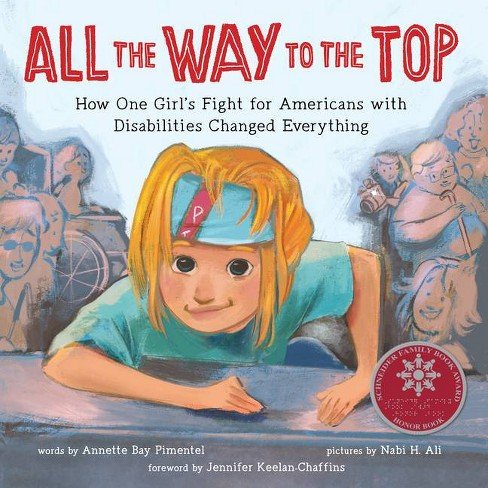
“All The Way To The Top” book lesson plan
In this lesson students will learn new vocabulary words and explore important civil rights themes by reading the book “All the Way to the Top” by Annette Bay Pimentel. “All the Way to the Top” tells the childhood story of Jennifer Keelan-Chaffins, who climbed all the way to the top of the stairs of the US capitol in 1990 to encourage congress to pass the Americans with Disabilities Act (ADA). Jennifer has cerebral palsy and became famous for the photos taken of her while climbing the stairs without a wheelchair at just 8 years old. The book tells the story from her perspective and covers how she felt she was not treated equally in her community and how she and other activist worked to get the ADA passed.
Image description: Cover artwork for “All the Way to the Top”

Black Disabled Art History Lesson
Students will select a Black Disabled artist from Leroy Moore’s Black Disabled Art History 101. Students will research their selected artist and their works. Students will choose a piece of artwork created by this artist and analyze it using a critical artistic framework. This lesson can be adapted for a wide range of ages.
Image description: Cover photo of Black Disabled Art History 101

Book Read A Loud Video List
On the YouTube page linked you will find a playlist with dozens of read a loud videos of books that we believe will add opportunities to incorporate disability representation in natural, positive ways to your class.
Image description: colorful books on a dark bookcase
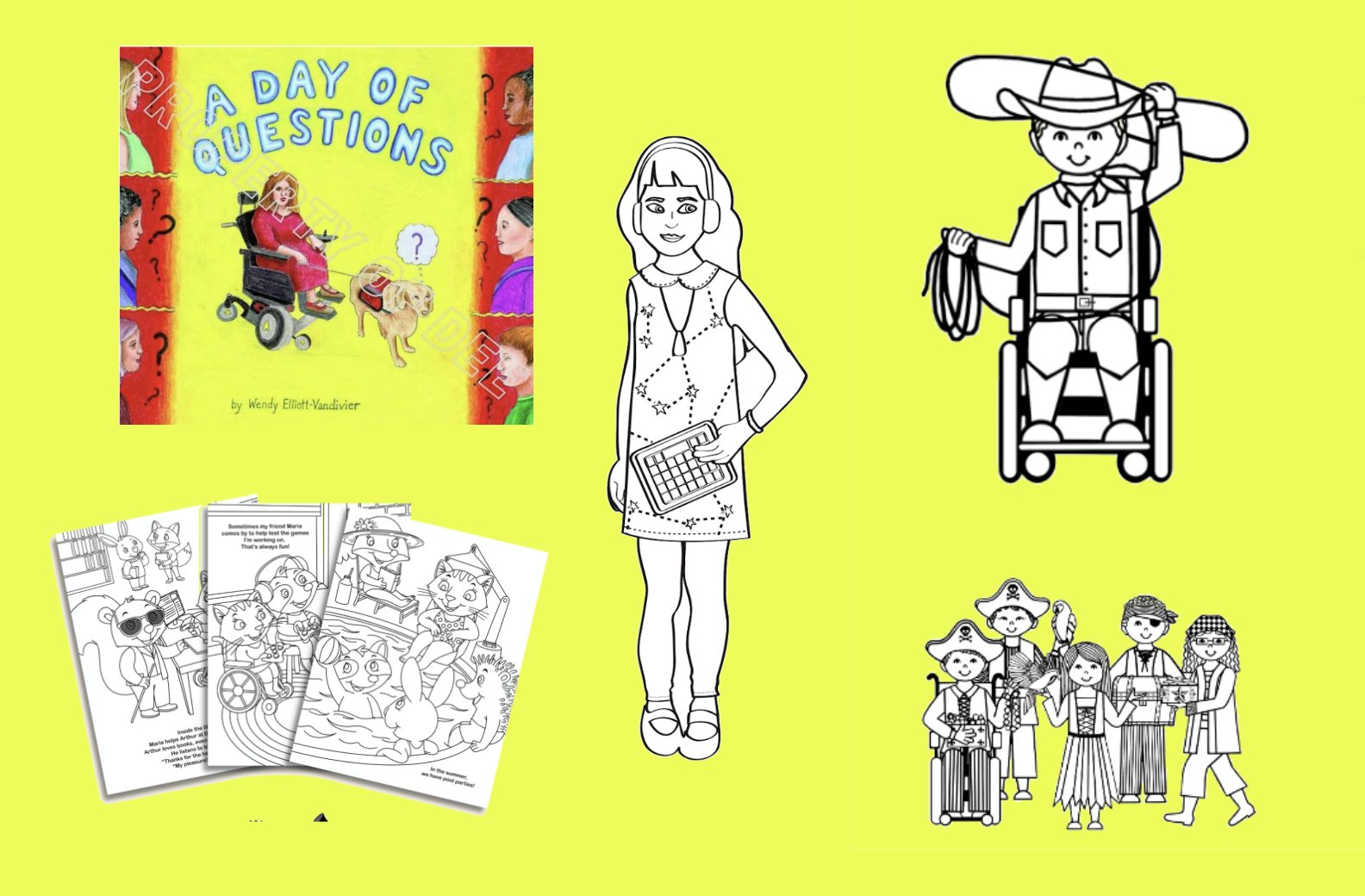
Coloring Books, Pages and Clip Art with Disability Representation
Including coloring pages and artwork in lessons (some of these allow you to use as clip art) that includes disability representation furthers the goal of regularizing disability by seeing it and offering opportunities to learn and ask questions.
Image Description: small images of the coloring books on a yellow background

Come Over to My House Lesson
Students will participate in an interactive read-aloud and discussion of the picture book “Come Over to My House” by Eliza Hull and Sally Rippin, exploring its representation of disabilities. They will respond to a writing prompt inspired by the book and create artwork to accompany their writing. The lesson concludes with reflective questions and optional follow-up activities to address student inquiries.
Image Description: Cover of a children's book titled "Come Over to My House." It features a group of children and a dog and 2 adults at an open door. One child is in a wheelchair, another is upside down, and there is a dog sitting in the middle. The children are smiling and appear welcoming.

Dad and Me in the Morning Guided Reading Lesson
This lesson revolves around the book Dad and Me in the Morning by Patricia Lakin. The book tells the short story of a boy and his dad getting up early to see the sunrise. The book is unique because the boy in the story is deaf and the book shows the different ways he and his dad communicate. It is a great example of how the disabled perspective can be brought to a story that most children can relate with. In this lesson the teacher will read the book page by page and stop on each page to have students figure out all the different ways the boy and his Dad are communicating. The students will compete to see who can find the most ways.
Image description: Cover art from “Dad and Me in the Morning” book

“Different: A Great Thing to Be!” - Similarities and Differences Lesson
This lesson has five activities which can be spread between multiple days as time allows within English Language Arts blocks. Through a teacher-led interactive read aloud and whole class discussion of the story: “Different: A Great Thing to Be” by Heather Avis, students will be encouraged to identify similarities between themselves and the main character in the story, Macy, and their classmates, as well as embrace differences within themselves, Macy and their classmates.
Image Description: a light purple background with 7 different colorful birds standing on a thin branch. The text above says “Each of us is different and that’s a good thing!” The word different is bigger and each letter is in vibrant different colorful patterns.

“Different - A Great Thing to Be” Rhyming Lesson
Students will identify personal similarities and differences between peers. Students will listen to read/listen to “Different… A Great Thing to Be” and identify rhyming words. After the lesson, students will write a poem about being different.
Image Description: cover of the book "Different: A Great Thing to Be!" includes an illustration of a girl with long brown hair holding flowers. Her eyes are closed and she's wearing glasses.
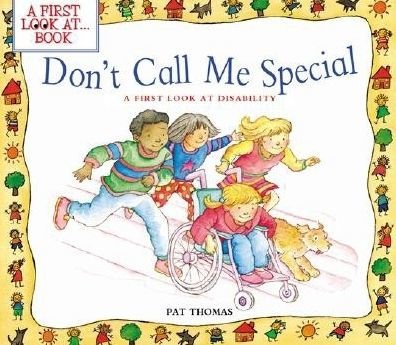
Don’t Call Me Special: Reading and Discussion
This is an introductory lesson on physical disability using the book “Don’t Call Me Special” by Pat Thomas. The educator will read aloud the book and ask questions about the text. Students will learn about making assumptions and what physical disability can look like, as well as how equipment can help students with disabilities access all parts of their life.
Image description: cover art for the book “Don’t Call Me Special”
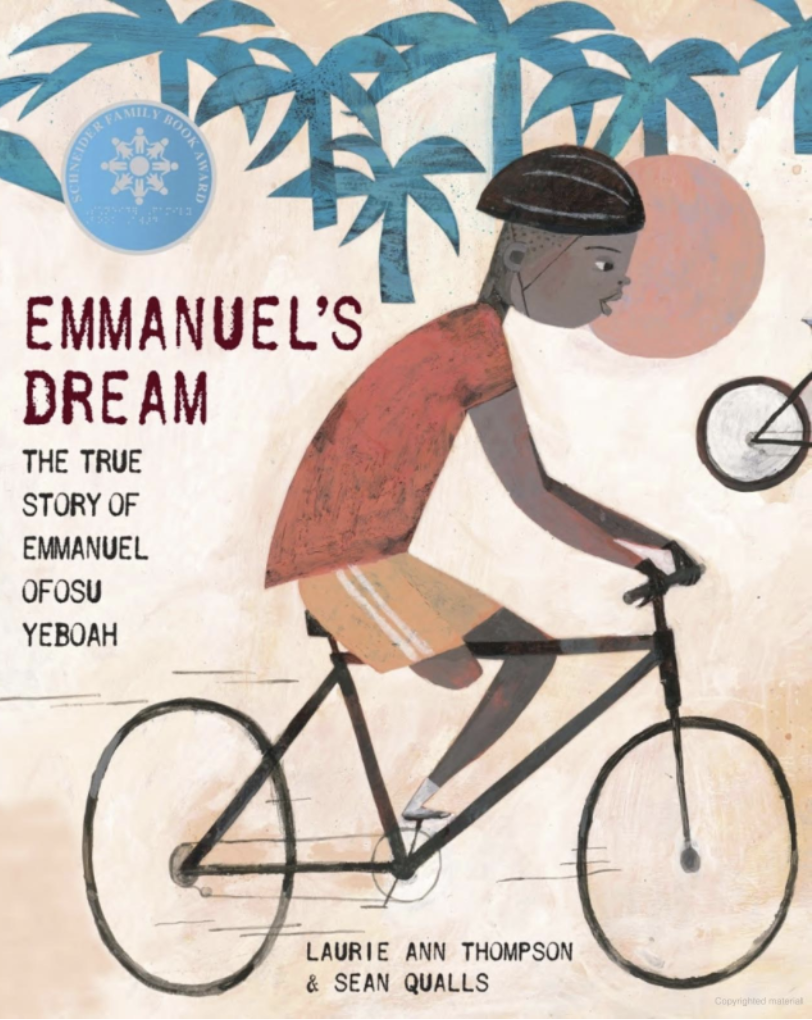
‘Emmanuel’s Dream’ Lesson Plan
Students will read ‘Emmanuel’s Dream’ by Laurie Ann Thompson, the true story of Emmanuel, a boy from Ghana who could only use one leg. Students will then complete a worksheet with a blank tshirt on it where they will write a word or phrase about how they are different but they are proud of that difference.
Image description: Cover image for “Emmanuel’s Dream”

Equity is Essential: Working to Achieve Access for All Lesson
Students will read Not So Different: What You Really Want to Ask About Having a Disability by Shane Burcaw and consider what it means to have a disability, what inclusion means and how to create a more accessible world.
Image description: Cover for the book “Not So Different: What You Really Want to Ask About Having a Disability”

Exploring Nancy Polette’s “The Spy with the Wooden Leg: The Story of Virginia Hall” with the help of a reading journal
The students will learn how to use a reading journal to aid their exploration of a biography “The Spy with the Wooden Leg: The Story of Virginia Hall” which will be read as a class and individually. This reading will be slow in order to help support students’ discovering how to read, process, and reflect upon biography in the form of a chapter book and use this information to enrich their study of History. Many aspects of this lesson are flexible and can be adapted to the needs of your students.
Some themes of war may be difficult for some students, it is recommended that no new difficult content be introduced on a Friday or before a long break so that the class can have the support they need as they learn about these difficult themes.
Image Description: cover of the book “The Spy with the Wooden Leg: The Story of Virginia Hall By Nancy Polette”
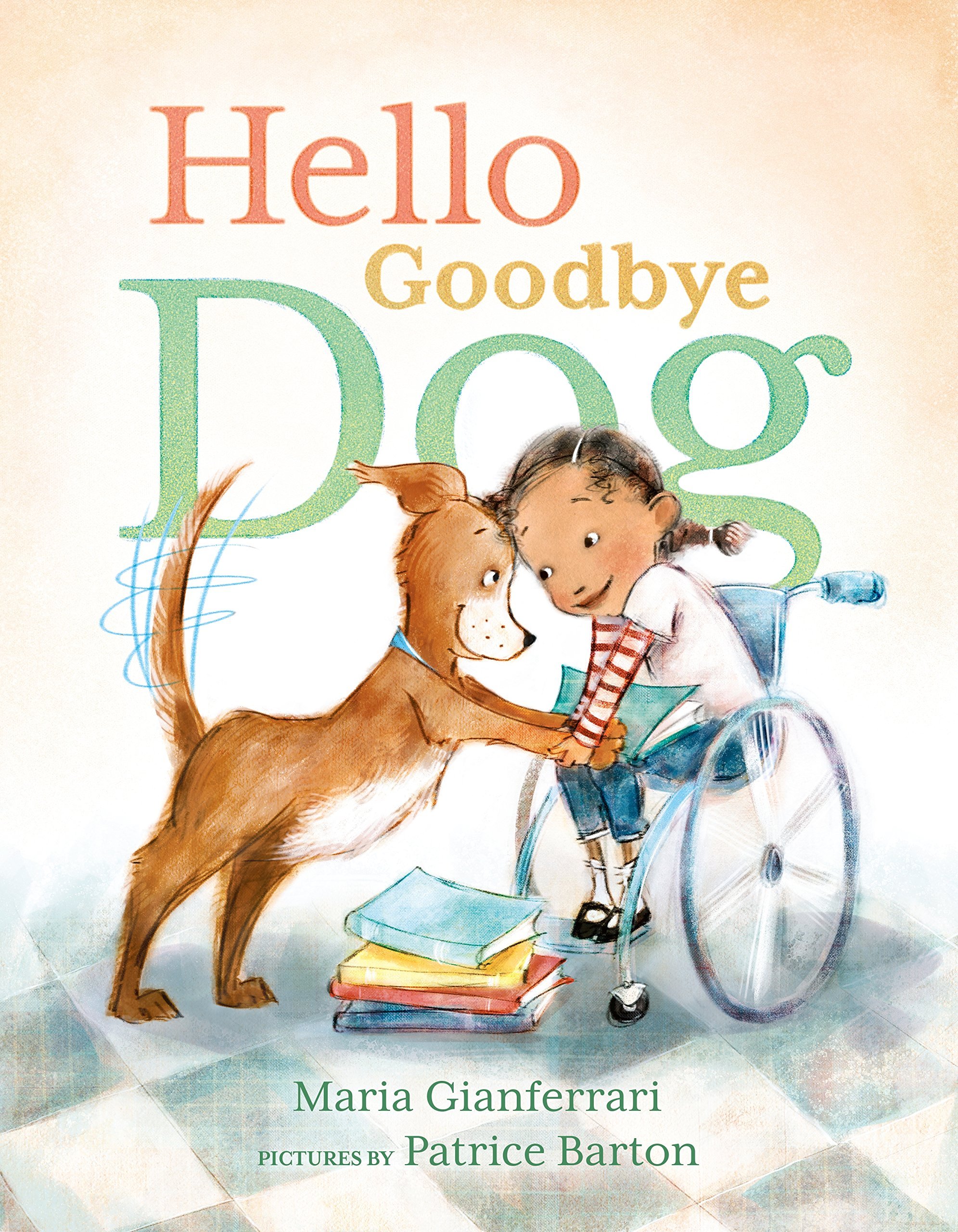
Hello Goodbye Dog: Reading about Service/Therapy Dogs and their Important Jobs
Students read Hello Goodbye Dog by Maria Gianferrari and read a short article about how a shelter dog helped a boy with epilepsy to live a safer and more fulfilling life.
Image description: Cover art from the book “Hello Goodbye Dog”

Hispanic Heritage: Frida Kahlo (Intersectionality of Ableism, Creativity and Feminism) Lesson
Frida Kahlo (1907 - 1954) was a Mexican artist who was influenced by the Mexican Revolution. She experienced a disability at two times in her life. Her determinism helped her cope with the pain of overcoming polio, a difficult marriage and bus-trolley accident. Frida Kahlo’s curiosity and love for nature were often the subjects of her paintings. Known as the “mother of the selfie,” Frida also created more than 200 paintings of herself. This unit of lessons is to recognize the creativity and imagination of Frida Kahlo.
Image description: Photograph of Frida Kahlo against a green floral background

I Deaf-initely Can, Rhett the Heeler
In this lesson, the teacher will read I Deaf-initley Can, Rhett the Heeler, a book about a Deaf girl who adopts a Deaf dog and teaches the dog sign language. The book shows the story from Rhett’s perspective of being chosen into Karlie’s family and learning about the world through sign language.
For discussion, students will think about other methods of communication. The takeaway message for students is that people (and dogs!) can communicate in many different ways—and all of them are valid.
Image Description: Cover of the book “I Deaf-initely Can - Rhett the Heeler” shows a girl and a dog sitting side by side on the grass facing away from us, looking at one another. There is a brown mountain range and sunset in the distance.

Into the Woods: Exploring Disabilities in Fairy Tales and Classic Stories
Using Amanda Leduc’s book “Disfigured: On Fairy Tales, Disability, and Making Space,” as inspiration students will consider different representations of disability in fairy tales and classic stories. They will watch an interview and a reading with Leduc, read 2 texts referenced in her book and learn to identify issues with how disabled people are presented and stereotyped. Students will produce two written assignments. One is an update to a classic story (either Beauty and the Beast or the Little Mermaid); the students will rewrite the classic tale to center and honor experiences of all bodies and abilities. The second assignment is a choice assignment. Students will either rewrite a second tale, or write a 1 page autobiographical story in the style of a fairy tale.
Image Description: The cover of the book “Disfigured: On Fairy Tales, Disability, and Making Space” by Amanda Leduc

It Feels Like Spring: How We Experience the Seasons Through Our Senses
After listening to the book, “Naomi Knows It’s Springtime” by Virginia Kroll, the students will consider how Naomi experiences springtime, and how they experience springtime with the senses they have. Then, they will further explore the tactile experience of springtime objects combined with a Math lesson.
Image description: Cover of the book “Naomi Knows It’s Springtime" showing a grassy field, someone pushing a lawnmower in the background, a girl with braided hair and a dog to her side, tail in the air, facing us seated at a garden

Maya Angelou Lesson
In this read-aloud of a picture book version of Maya Angelou’s “Life Doesn’t Frighten Me”, students will learn about and discuss fear, what it means to be brave, and how to cope when feeling scared. Students will learn about Maya Angelou and selective mutism, which is an anxiety disorder that Maya Angelou experienced for 5 years during adolescence.
Image description: Sketch of Maya Angelou

My Travelin’ Eye Lesson Plan
In this lesson the teacher will read aloud My Travelin’ Eye. This book shows from the character’s perspective what it is like to be on the receiving end of bullying and how she had to cope. As a way of coping Jenny’s mom made her special fashion eye patches. The takeaway message for students is that people who look different and have disabilities are still people in the world just like them.
Image description: Cover art for the book “My Travelin’ Eye”

Out of my Mind - Book Discussion Guide
Out of My Mind is narrated by a girl with cerebral palsy who's very intelligent but unable to express herself by speaking or physically. When Melody is integrated into some general classes at school, many kids are purposely mean; others, including teachers, are cruel through their assumptions that Melody is incapable of understanding them. With the help of her parents and some supportive friends and teachers, Melody acquires a machine that allows her to communicate better than she ever has before (Common Sense Media). At last Melody has a voice… but not everyone around her is ready to hear it (Draper, 2010). This book discussion guide can also be adapted into a full assignment if that is more applicable for your student group.
Image description: Cover from the book “Out of My Mind”
